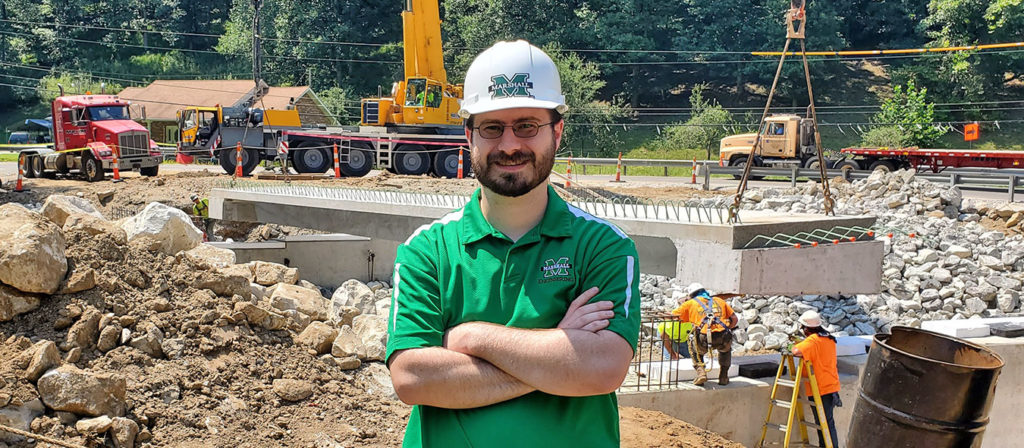Dr. Greg Michaelson, an assistant professor of engineering at Marshall University, has assisted the Short Span Steel Bridge Alliance (SSSBA) and the West Virginia Department of Highways (WVDOH) in developing West Virginia’s first press-brake-formed steel tub girder bridge. Crews began work to erect the bridge Tuesday, Aug. 20, near East Lynn in Lincoln County, District 2, and work is expected to continue through November.
Michaelson helped research and develop the innovative technology for the 58-foot-span Fourteen Mile Bridge. Contractor for the project is ORDERS Construction Company of Saint Albans. A second press-brake-formed steel tub girder bridge is expected to be constructed on U.S. 250 over Flat Run near Mannington, West Virginia, in 2020.
“We are very excited that one of the Marshall University engineering division faculty, Dr. Gregory Michaelson, can be a part of the process of testing bridge girders as they are being built into the bridge structure for the State of West Virginia,” said Dr. Asad Salem, engineering division chair. “The division is very supportive of this opportunity to support the West Virginia community.”
Dr. Wael Zatar, dean of Marshall’s College of Information Technology and Engineering (CITE), said CITE and Marshall University are very fortunate to have Michaelson as a faculty member.
“Dr. Michaelson has been conducting impressive research to advance the knowledge pertaining to steel girder bridges,” Zatar said.
The press-brake-formed tub girder system consists of galvanized shallow trapezoidal boxes fabricated from cold-bent structural steel plate. A concrete deck is precast on the girder, making it a modular unit that can be transported by truck to the project site. The system is ideal for spans up to 60 feet. It saves time and costs for bridge owners since it can be installed as a single modular unit usually in one or two days by local crews, will last for an estimated 100 years, and requires minimal maintenance during its lifetime.
The expedited installation process ensures the new bridge is opened for service in a timely manner, minimizing disruption to traffic.
The Short Span Steel Bridge Alliance aims to keep bridge owners and designers informed about the benefits, latest design innovations, cost competitiveness and performance of steel in short-span installations up to 140 feet in length. Michaelson is part of the SSSBA’s Bridge Technology Center, which is overseeing the Fourteen Mile Bridge project. Michaelson and Dr. Karl Barth of West Virginia University have conducted extensive research on the press-brake-formed steel tub girder system for the past six years, including development and design, experimental testing, field evaluations, and feasibility and economic studies.
“We envision the PBTG system as the future of short span steel bridge design,” Michaelson said. “West Virginia is the fifth state in the U.S. to implement this new system, along with Iowa, Ohio, Michigan and Texas. We commend the WVDOH for recognizing its potential and ORDERS Construction Company for turning our dream into reality.”
Michaelson previously worked on an award-winning, short-span bridge in Muskingum County, Ohio. It was the first press brake tub girder structure to utilize the SPS Deck system, providing an all-steel solution that not only helped avoid a lengthy traffic closure but also was a shallow superstructure with a lack of horizontal surface, which was beneficial because of the structure’s location over a stream that is prone to flooding. It earned a 2018 Technological Advancement Award from the National Steel Bridge Alliance.
The focus of Michaelson’s research for past few years has been trying to make short-span steel bridge design more economical and efficient. Of the nation’s roughly 600,000 bridges, more than 90% are short-span bridges that are less than 150 feet long, he said.
“If you find way to make short-span bridges more economical, you save taxpayers a lot of money,” Michaelson said. “WVU and Marshall came together on this, and it was great that we produced something that is actually being used. As a researcher, you hope that your work has a direct impact. There are going to be folks driving over this every day, so there’s a real benefit.”
Originally from Jean Hardiman for Marshall University Communications.
